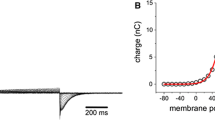Summary
The electrical responses of individual hemocyanin channels in oxidized cholesterol membranes demonstrate that the voltage-dependent conductance of many-channel membranes arises from two different mechanisms. These are the voltage-dependent redistribution of channels among several discrete single-channel conductance states and the continuously voltage-dependent conductance of the single-channel states themselves. The relaxation time for the discrete conductance changes is of the order of seconds and the relaxation time of the continuous conductance changes is of the order 10−4 seconds. As salt concentration in the bathing medium is increased, the single-channel conductance first increases linearly and then saturates. The characteristics of the saturation curves suggest that the continuous conductance changes occur at the edges of the channel and that the mean time an ion spends in the channel is 4 nanoseconds.
Similar content being viewed by others
References
Alvarez, O., Diaz, E., Latorre, R. 1975. Voltage-dependent conductance induced by hemocyanin in black lipid films.Biochim. Biophys. Acta 389:444
Alvarez, O., Latorre, R., Verdugo, P. 1975. Kinetic characteristics of the EIM channel in oxidized cholesterol and brain lipid bilayer membranes.J. Gen. Physiol. 65:421
Bean, R.C., Shepherd, W.C., Chan, H., Eichner, J.T. 1969. Discrete conductance fluctuations in lipid bilayer protein membranes.J. Gen. Physiol. 53:741
Cole, K.S. 1965. Electrodiffusion models for the membrane of squid giant axon.Physiol. Rev. 45:340
Ehrenstein, G., Blumenthal, R., Latorre, R., Lecar, H. 1974. Kinetics of the opening and closing of individual excitability-inducing material channels in a lipid bilayer.J. Gen. Physiol. 63:707
Ehrenstein, G., Lecar, H. 1972. The mechanism of signal transmission in nerve axons.Annu. Rev. Biophys. Bioeng. 1:347
Ehrenstein, G., Lecar, H., Nossal, R. 1970. The nature of the negative resistance in bimolecular lipid membranes containing excitability-inducing material.J. Gen. Physiol. 55:119
Eisenberg, M., Hall, J.E., Mead, C.A. 1973. The nature of the voltage-dependent conductance induced by alamethicin in black lipid membranes.J. Membrane Biol. 14:143
Gordon, L.G.M., Haydon, D.A. 1972. The unit conductance channel of alamethicin.Biochim. Biophys. Acta 255:1014
Hille, B. 1970. Ionic channels in nerve membranes.Prog. Biophys. Mol. Biol. 21:1
Hille, B. 1971. The permeability of the sodium channel to organic cations in myelinated nerve.J. Gen. Physiol. 58:599
Hladky, S.B., Haydon, D.A. 1970. Discreteness of conductance change in bimolecular lipid membranes in the presence of certain antibiotics.Nature 225:451
Knott, G.D., Reece, D.K. 1972. MLAB: A civilized curve-fitting system.In: Proc. ONLINE '72 Int. Conf., Brunel University, England1:497
Konings, W.N., Siezen, R.J., Gruber, M. 1969. Structure and properties of hemocyanins. VI. Association-dissociation behaviour ofHelix pomatia hemocyanin.Biochim. Biophys. Acta 194:376
Latorre, R., Ehrenstein, G., Lecar, H. 1972. Ion transport through excitability-inducing material (EIM) channels in lipid bilayer membranes.J. Gen. Physiol. 60:72
Läuger, P. 1973. Ion transport through pores: A rate theory analysis.Biochim. Biophys. Acta 311:423
Montal, M., Mueller, P. 1972. Formation of bimolecular membranes from lipid monolayers and a study of their electrical properties.Proc. Nat. Acad. Sci. USA 69:3561
Mueller, P., Rudin, D.O., Tien, H.T., Wescott, W.C. 1964. Formation and properties of bimolecular lipid membranes.Rec. Prog. Surface Sci. 1:379
Pant, H.C., Conran, P. 1972. Keyhole limpet hemocyanin (KLH)—lipid bilayer membrane (BLM) interaction.J. Membrane Biol. 8:357
van Bruggen, E.F.J., Schuiten, V., Wiebenga, E.H., Gruber, M. 1963. Structure and properties of hemocyanins. III. Electron micrographs of hemocyanins from different gastropoda and crustacea.J. Mol. Biol. 7:249
van Bruggen, E.F.J., Wiebenga, E.H., Gruber, M. 1962a. Structure and properties of hemocyanins. I. Electron micrographs of hemocyanin and apohemocyanin fromHelix pomatia at different pH values.J. Mol. Biol. 4:1
van Bruggen, E.F.J., Wiebenga, E.H., Gruber, M. 1962b. Structure and properties of hemocyanins. II. Electron micrographs of the hemocyanins ofSepia officinalis, Octopus vulgaris, andCancer pagurus.J. Mol. Biol. 4:8
Author information
Authors and Affiliations
Rights and permissions
About this article
Cite this article
Latorre, R., Alvarez, O., Ehrenstein, G. et al. The nature of the voltage-dependent conductance of the hemocyanin channel. J. Membrain Biol. 25, 163–181 (1975). https://doi.org/10.1007/BF01868573
Received:
Revised:
Issue Date:
DOI: https://doi.org/10.1007/BF01868573




